Home > Info > How To Play > How to Play Other Kalimbas
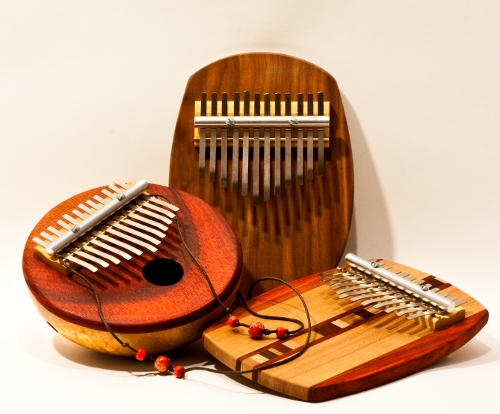
This page deals with a few resources for some of the orphans that don’t have pages of their own: Hugh Tracey Bb Treble, D Treble, and Hotshot-11, as well as the Hokema 5-Note Kalimba Choirs.
The Hugh Tracey HotShot-11 is a great little diatonic kalimba – a good instrument for children or beginners, and a stepping stone to the Alto Kalimba.
We still have some instructional material for the old Catania 12-Note Kalimbas. These kalimbas were tuned to the key of C, but with the low note of G… but the G belonged to the left side. If you have a 12-Note kalimba in another tuning, it can surely be tuned into a complementary tuning to work with the songs in this collection.
The Afroharp was a child of the late 1960s. While it did not succeed, there were plenty of people who loved them. This instructional download / book will work for the original G major / E minor tuning of the Afroharp. It turns out the Hugh Tracey Alto kalimba can also be set up as an Afroharp.
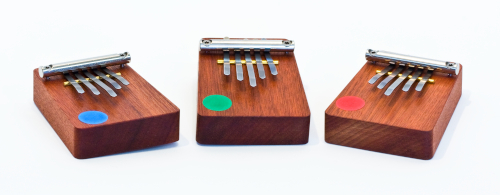
The 5-Note Chordal Kalimba Choirs represent a unique advance in kalimba technology and music instruction. The big idea: each kalimba is tuned to a different 5-Note chord, and the three, four, or five different chords you have in your choir are designed to work together to create real music. For example, C, F, and G7 work together to create thousands of songs that follow the I-IV-V chord progression. If your three (or four, or five) students can take turns, each playing a short phrase of a measure, they can make complex group music with only a minute of instruction. Simply amazing!
Learn more about the Chordal Kalimba Choirs! Whatever chords or keys you need, we can come through for you! If your kalimbas are used a lot, you will have to touch up on the tuning every six months or so.
The 5-Note Kalimbas are also sold separately and can be tuned to any chord, but not any voicing of the chord.
Here are some of the chords with tunings we have put together:
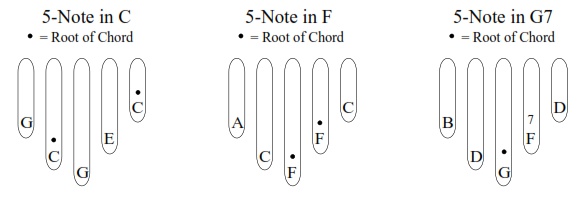
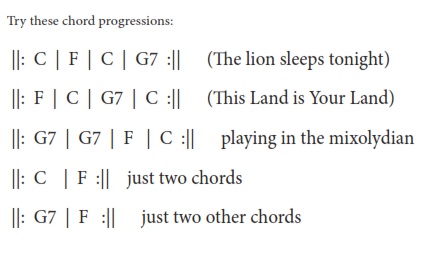
Demonstrating the depth of what can done with these chordal kalimbas.
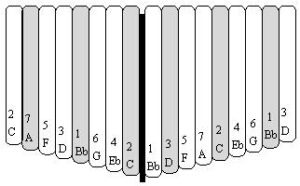
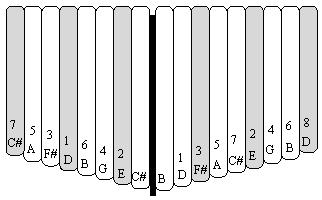
The Hugh Tracey Bb Treble and D Treble are alterations of the standard Treble kalimba, which is in the key of G but has a B as the low note and D as a high note. As you can see in the tuning diagrams, these two kalimba setups basically keep that same range from B to D… but we have tuned a few tines to be in the key of either Bb or D.
The Bb Treble has two octaves of continuous Bb Major scale, starting at the bottom… with two extra notes at the top (C and D).
The D Treble has the two extra notes at the bottom of the scale B and C#), and then it has the two continuous octaves of D Major scale above that, ending on the high D.
Logically, the Bb and D family of Trebles are based on the layout of the Alto kalimba, and they use Alto resources – which is wonderful, because the Alto kalimba has more books, downloads, Tips of the Day, and other resources than any other kalimba.
This video explains how the Bb and D Trebles are related to the Alto Kalimba, and how this family spans every key.
Basically, there are an infinite number of varieties of kalimba. If you went into your garage and created your own kalimba with an invented tuning, there is a good probability that you would walk out with a tuning that already exists (the 8-Note C Kalimba for example), but there is also a good probability that you would invent a tuning that I have never seen before.
Believe it or not, it is not my mission to create instructional material for every possible kalimba. Kalimba Magic actually doesn’t sell absolutely every type of kalimba that exists. When I see an interesting or amazing kalimba, I often do decide to sell it at Kalimba Magic. However, in order to help you jump start your kalimba experience, I try to write up some information on how to play that kalimba. In other words, I sell the kalimbas that I love, and I write books for them based on my experience with them to help sell the kalimbas.
If you have a kalimba that has a different note layout or tuning from anything that I offer, you won’t find any books or downloads here that will work for your kalimba. You have several options:
What about kalimbas not sold at Kalimba Magic? For example, what about the Indonesian 7-Note Kalimbas? You could use 6 or 8-note instructional materials for them if you get the tuning right. Read here for some more ideas for playing these other kalimbas.
If you still have questions after reading this, please send me a message to let me know what you need to find out. INSERT CONTACT LINK
If you have any questions, feel free to contact us via the email form, or speak directly to Mark Holdaway at 520-488-7641.Contact Us


Sign up for our newsletter and free resources with your email address:
We pinky promise not to spam you and to only send good stuff.
 Christmas in July 2025
Christmas in July 2025 Patriotic and American Music for Kalimba
Patriotic and American Music for Kalimba